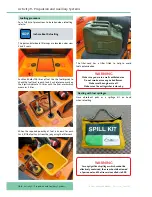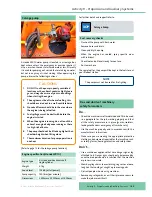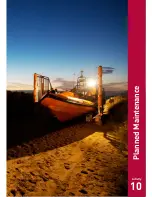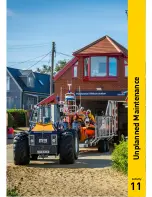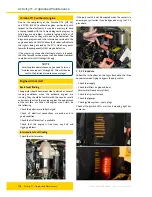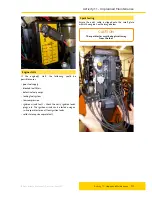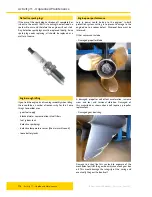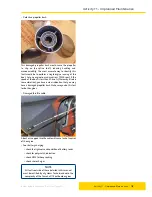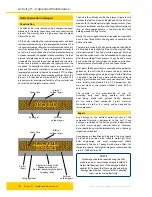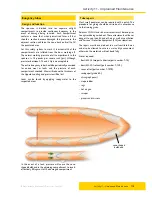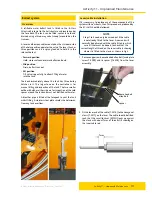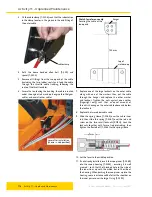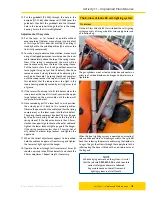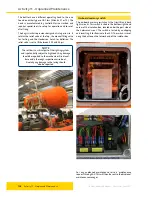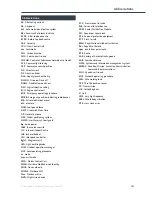
114
Activity 11 - Unplanned Maintenance
B Class Atlantic 85 Manual – First Issue, June 2017
Activity 11 - Unplanned Maintenance
Hull construction and repair
Construction
The Atlantic 85 is constructed using a composite epoxy/
closed cell structural foam core sandwich construction
process. The majority have a high percentage of carbon
fibre in their hulls.
All the hulls, including the internal components and deck
sections are made using a pre-impregnated material. This
is a specialist composite material manufactured with a dry
resin film backed onto it. The pre-impregnated material is
cut off a roll, cut to shape and after the protective backing
has been removed, it is applied into the mould dry. It is then
pressed into place by hand and using rollers. This process
is repeated to form the layers that make up the structure.
Foam core is placed in between the layers to form the
sandwich. To consolidate, these layers are vacuumed in
place and the mould is placed in an oven where the pre-
impregnated material is heated to around 50
℃
to allow
the resin to infuse into the composite material. After this
process, it is then baked at around 80
℃
to harden. This
process ensures maximum effectivity of the material and
ensures the hull weights are consistent.
The hull is then fitted out with the internal structure; this
includes the fuel tank floor and bulkhead. All the hulls are
made with 10 individual watertight compartments, (four
transverse bulkheads and two main longitudinal sections).
One of these compartments is the main ballast tank
holding around 270kg of water.
Finally, the main ring deck section is bonded on. A portable
deck is then fitted within the ring deck to complete the
hull construction.
There are two variants of hull construction on the Atlantic
85. Early boats were slightly different in the way that they
were constructed. They had a white epoxy gel finish on
the outside, which meant the hull needed painting orange
after the moulding/fit out process. They also had a more
basic carbon/foam core/carbon sandwich construction.
These were manufactured by Gurit and Green Marine
Later boats (B834 onwards) are moulded with a polyester
gelcoat on the hull side. This means the boat could be
finished with orange gel so no painting or further finishing
is required. They also have a more substantial hull layup
using E-glass/carbon and foam core construction. These
were initially manufactured by PE Composites, but
are now made at the Inshore Lifeboat Centre (ILC) in
East Cowes.
The console is also manufactured at the ILC
(similarly early ones being painted, with later
ones being made with gelcoat finish), however
all are made from composite E-glass material.
No carbon is used as it is costly and not required for
this component.
Repair
Any damage to the external watertight seal of the
composite structure is detrimental to the hull. If any
damage is sustained to the hull, any cracks, delamination
or stress marks appear, the mechanic or Divisional
Base should be contacted immediately and a thorough
inspection carried out.
Once damage is identified and reported, the area should
be dried and covered with suitable watertight filler.
RNLI engineering and asset management (EAM)
recommend the use of epoxy based marine fillers for
temporary repairs. For larger damage we recommend the
use of C-1389 Kollision Kit
NOTE
All damage should be reported using the EAM
module on AX as a maintenance request (old SAP
Defect Notification). Even if the damage is filled it
enables ILC to know that there may be underlying
damage when the boat returns for refit, allowing
them to plan more effectively.
Older hulls
Newer hulls
(B834 onwards)
Internal
carbon layers
Internal
carbon layers
External
carbon layers
External
carbon layers
Epoxy gel
Foam Core
Foam Core
Orange gelcoat
E-glass
layers
Vinylester tie coat with
chopped strand mat
(to allow polyester gel to bond
to epoxy resin)
Содержание Atlantic 85
Страница 1: ...B CLASS ATLANTIC 85 MANUAL...
Страница 2: ......
Страница 4: ......
Страница 8: ......
Страница 11: ...Activity 2 Personal Competencies Personal Competencies Activity 2...
Страница 31: ...Activity 3 Launch and Recovery Launch and Recovery Activity 3...
Страница 37: ...Activity 4 SAR Unit Handling and Seamanship SAR Unit Handling and Seamanship Activity 4...
Страница 51: ...Activity 5 Search and Rescue Search and Rescue Activity 5...
Страница 57: ...Activity 6 Communications Communications Activity 6...
Страница 67: ...Activity 7 Navigation Navigation Activity 7...
Страница 70: ......
Страница 71: ...Activity 9 Propulsion and Auxiliary Systems Propulsion and Auxiliary Systems Activity 9...
Страница 106: ......





